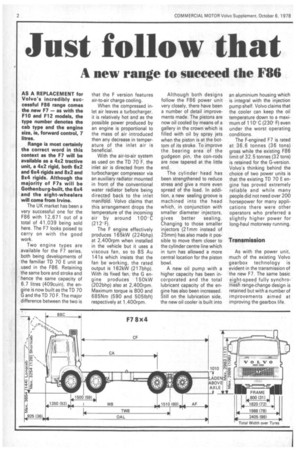Just follow that
Page 86

If you've noticed an error in this article please click here to report it so we can fix it.
A new range to succeed the F86
AS A REPLACEMENT for Volvo's incredibly successful F86 range comes the new F7 — as with the F10 and F12 models, the type number denotes the cab type and the engine size, ie, forward control, 7 litres.
Range is most certainly the correct word in this context as the F7 will be available as a 4x2 tractive unit, a 4x2 rigid, both 6x2 and 6x4 rigids and 8x2 and 8x4 rigids. Although the majority of F7s will be Gothenburg-built, the 6x4 and the eight-wheelers will come from Irvine.
The UK market has been a very successful one for the F86 with 12,671 out of a total of 41,039 being sold here. The F7 looks poised to carry on with the good work.
Two engine types are available for the F7 series, both being developments of the familiar TD 70 E unit as used in the F86. Retaining the same bore and stroke and hence the same capacity of 6.7 litres (409cuin), the engine is now built as the TD 70 G and the TD 70 F. The major difference between the two is that the F version features air-to-air charge cooling.
When the compressed inlet air leaves a turbocharger, it is relatively hot and as the possible power produced by an engine is proportional to the mass of air introduced then any decrease in temperature of the inlet air is beneficial.
With the air-to-air system as used on the TD 70 F, the inlet air is directed from the turbocharger compressor via an auxiliary radiator mounted in front of the conventional water radiator before being directed back to the inlet manifold. Volvo claims that this arrangement drops the temperature of the incoming
air by around 100. C (212'. F).
The F engine effectively produces 165kW (224bhp) at 2,400rpm when installed in the vehicle but it uses a viscous fan, so to BS Au 141a which insists that the fan be working, the rated output is 162kW (217bhp). With its fixed fan, the G engine produces 150kW (202bhp) also at 2,400rpm. Maximum torque is 800 and 685Nm (590 and 505Ibft) respectively at 1,400rpm. Although both designs follow the F86 power unit very closely, there have been a number of detail improvements made. The pistons are now oil cooled by means of a gallery in the crown which is filled with oil by spray jets when the piston is at the bottom of its stroke. To improve the bearing area of the gudgeon pin, the con-rods are now tapered at the little end.
The cylinder head has been strengthened to reduce stress and give a more even spread of the load. In addition, a new sealing groove is machined into the head which, in conjunction with smaller diameter injectors, gives better sealing. Changing to those smaller injectors (21mm instead of 25mm) has also made it possible to move them closer to the cylinder centre line which in turn has allowed a more central location for the piston bowl.
A new oil pump with a higher capacity has been incorporated and the total lubricant capacity of the engine has also been increased. Still on the lubrication side, the new oil cooler is built into an aluminium housing which is integral with the injection pump shelf. Volvo claims that the cooler can keep the oil temperature down to a maximum of 110" C (230' F) even under the worst operating conditions.
The F-engined F7 is rated at 36.6 tonnes (36 tons) gross while the existing F86 Limit of 32.5 tonnes (32 tons) is retained for the G-version. Volvo's thinking behind the choice of two power units is that the existing TD 70 E engine has proved extremely reliable and while many people did not need over 200 horsepower for many applications there were other operators who preferred a slightly higher power for long-haul motorway running.
As with the power unit, much of the existing Volvo gearbox technology is evident in the transmission of the new F7. The same basic .eight-speed fully synchromesh range-change design is retained but with a number of improvements aimed at improving the gearbox life.


























































































































































